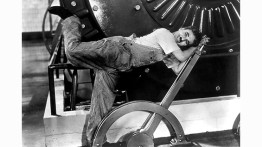Slapstick, Technology & Contemporary Art
Tuesday, April 19, 2016, 7 - 8:30pm

Charlie Chaplin in 'Modern Times' (1936)
In a free, public lecture Ruba Katrib examines how slapstick and gags emerged in early 20th century popular entertainment as a new type of humor that in part responded to an increased reliance on machine technologies. The talk will explore the humorous collision and intertwining of bodies and machines in early cartoons, film, and circus entertainment in the early 20th century, and posits parallels in contemporary art practices.
Ruba Katrib is the Curator at SculptureCenter in Long Island City, New York where she has produced group shows The Eccentrics (2015), Puddle, Pothole, Portal (2014) (co-curated with artist Camille Henrot), Better Homes (2013), and A Disagreeable Object (2012). Recent solo shows include exhibitions with Rochelle Goldberg (2016), Anthea Hamilton, Gabriel Sierra, Magali Reus, Michael E. Smith, and Erika Verzutti (all 2015). In her previous post as the Associate Curator at the Museum of Contemporary Art (MOCA), North Miami, she organized several acclaimed solo and group exhibition including The Reach of Realism (2009), which explored the traditions of realism within the digital age, as well as the first museum retrospectives of Cory Arcangel and Claire Fontaine (both 2010). Katrib has contributed texts for a number of publications and periodicals including Art in America, Parkett, and cura. magazine. She has also co-curated with Tom Eccles, Visitors, a group exhibition of public art on Governors Island, New York (2015).
This lecture is part of the Spring 2016 Intradisciplinary Seminar, part of the Robert Lehman Visiting Artist Program at The Cooper Union. We are grateful for major funding support from the Robert Lehman Foundation, Inc.
Located in the Frederick P. Rose Auditorium, at 41 Cooper Square (on Third Avenue between 6th and 7th Streets)




